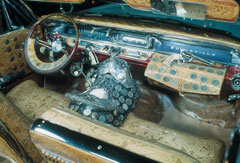
About UsThe Numismatic Bibliomania Society is a non-profit organization promoting numismatic literature. For more information please see our web site at coinbooks.org SubscriptionsThose wishing to become new E-Sylum subscribers (or wishing to Unsubscribe) can go to the following web page link MembershipThere is a membership application available on the web site Membership Application To join, print the application and return it with your check to the address printed on the application. Membership is only $15 to addresses in the U.S., $20 for First Class mail, and $25 elsewhere. For those without web access, write to: David M. Sundman, Secretary/TreasurerNumismatic Bibliomania
Society AsylumFor Asylum mailing address changes and other membership questions, contact David at this email address: dsundman@LittletonCoin.com SubmissionsTo submit items for publication in The E-Sylum, just Reply to this message, or write to the Editor at this address: whomren@coinlibrary.com
BUY THE BOOK BEFORE THE COINYou won't regret it! |
- WAYNE'S WORDS: THE E-SYLUM JULY 18, 2010
- LAKE BOOKS SALE #103 PRICES REALIZED AVAILABLE
- NUMISMATIC LITERATURE IN HERITAGE ANA AUCTION
- NEW BOOK: GUIDE BOOK OF MODERN UNITED STATES PROOF COIN SETS, 2ND EDITION
- BOOK REVIEW: ASTRONOMICAL SYMBOLS ON ANCIENT AND MEDIEVAL COINS
- BOOK REVIEW: GOLD: EVERYTHING YOU NEED TO KNOW TO BUY AND SELL TODAY
- QUERY: ALAIN DEBELDER'S BELGISCH NOODGELD SOUGHT
- QUERY: SAMUEL MOORE AND ADAM ECKFELDT INFORMATION SOUGHT
- MORE ON MEDAL ENGRAVER BLUMENFELD
- MORE ON THE NEW ENGLAND NUMISMATIC AND ARCHAEOLOGICAL SOCIETY PRLS
- ON RESTORING LEATHER BOOK COVERS
- QUERY: VIETNAMESE BANKNOTE OVERSTAMP TRANSLATION SOUGHT
- QUERY: ROBERT READY AND SONS, ELECTROTYPISTS
- ARTICLE PROFILES BILL BURD AND HIS NUMISMATIC LIBRARY
- MORE ON THE LIBRARY OF COINS AND TREASURY OF COINS ALBUMS
- CHIPS, THE DOG WITH A PURPLE HEART
- OPINION: TIM SHUCK ON COIN DESIGN BY COMMITTEE
- NOTES FROM E-SYLUM READERS: JULY 18, 2010
- ROY ROGERS' SILVER-DOLLAR STUDDED CAR
- THE HOBBIES MAGAZINE BUILDING IN CHICAGO
- ARTICLE: TRINIDAD MAN READY TO PART WITH HIS "RARE" COIN
- ARTICLE PROFILES FORMER B.E.P. ENGRAVER THOMAS HIPSCHEN
- ON GERMAN MICRO-CURRENCIES
- INDIA UNVEILS NEW RUPEE SYMBOL
- CONFUSION REIGNS AS SOUTH AFRICA OUTLAWS OLD BANKNOTES
- FEATURED WEB SITE: EUROCOLLEZIONE, A EURO COINS SITE
WAYNE'S WORDS: THE E-SYLUM JULY 18, 2010

Among our new subscribers this week is Brian Cushing. Welcome aboard! We now have 1,362 subscribers.
This week we open with a note from Fred Lake on his recent sale, announcements and reviews of three books. Other topics this week include Samuel Moore and Adam Eckfeldt, electrotypists Robert Ready and sons, Bill Burd's numismatic library, and BEP engraver Tom Hipschen.
To learn about Archaeoastronomy, Roy Rogers' coin-studded car, and Chips, the dog with a Purple Heart, read on. Have a great week, everyone!
Wayne Homren
Numismatic Bibliomania Society
LAKE BOOKS SALE #103 PRICES REALIZED AVAILABLE
The prices realized list for our sale #103 which closed on July 13, 2010 is now available for viewing on our web site at http://www.lakebooks.com/current.html
The sale was very active with classic books on British medals, Redbooks, US reference material and exonumia bringing high prices.
Our next sale will be held in mid-September and features the very extensive library of noted columnist and numismatist Col. William Bain Murray. Many of these fine reference books have been personally inscribed to Bill by the authors. You won't want to miss this sale.
Lake Books
6822 22nd Ave. N.
St. Petersburg, FL 33710
727-343-8055 Fax 727-345-3750
NUMISMATIC LITERATURE IN HERITAGE ANA AUCTION
Two lots in the official American Numismatic Association Auction in Boston will be of special interest to numismatic literature collectors.
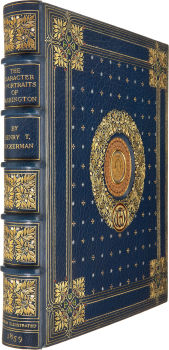 The first lot will be in the Platinum Night session (lot 3016). An extra-illustrated, leather-bound edition of Henry Tuckerman's 1859 The Character and Portraits of Washington includes about 90 engravings or lithographs of or related to George Washington. The binding is a fancy custom leather binding by Sangorski and Sutcliffe of London, and the extra illustrations were assembled by Goodspeed's of Boston. Included is an 1773 ALS in Washington's hand, and incorporated in the front cover is an original George Washington gold funeral medal.
The first lot will be in the Platinum Night session (lot 3016). An extra-illustrated, leather-bound edition of Henry Tuckerman's 1859 The Character and Portraits of Washington includes about 90 engravings or lithographs of or related to George Washington. The binding is a fancy custom leather binding by Sangorski and Sutcliffe of London, and the extra illustrations were assembled by Goodspeed's of Boston. Included is an 1773 ALS in Washington's hand, and incorporated in the front cover is an original George Washington gold funeral medal.
A further description is available at: coins.ha.com/common/view_item.php?Sale_No=1143&LotIdNo=34001 .
Of special interest to numismatists is Appendix III, a list of 49 items of Washingtonia, reprinted from the Boston Transcript edition of February 10, 1859. The list includes fascinating tidbits of information, such as an early account identifying Martha Washington as the model for the 1792 half disme, pedigree information attributing certain pieces to the collections of contemporary numismatists like Jeremiah Colburn and Reverend Finotti, and general observations on Washingtonia in 1859. The item is signed A.S. (possibly Augustus B. Sage).
Perhaps the most interesting feature of the present volume is the oval, gold George Washington Funeral medal, Baker-169, mounted in a recessed pocket of the front cover. This medal was originally designed for women, to be worn in lockets or other jewelry. The pieces were marketed by Eben Moulton, a Boston goldsmith and jeweler, in January 1800.
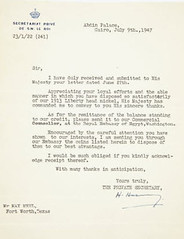 The second item (lot 5550) is a 30-year correspondence file of B. Max Mehl including testimonial and other letters that Mehl received from various consigners and other parties over a period of 30 years, dating from January 28, 1920 to March 8, 1950.
The second item (lot 5550) is a 30-year correspondence file of B. Max Mehl including testimonial and other letters that Mehl received from various consigners and other parties over a period of 30 years, dating from January 28, 1920 to March 8, 1950.
Letters were received from a veritable who's who of early 20th century numismatics, including James H. Manning, Charles Slack, George Blake, Alex Rosborough, George Bauer, William C. Atwater, Jr. (the son of the Atwater the coin collector), The National McKinley Birthplace Memorial Association, Fred Olsen, William Philpott, Jr., the private secretary of King Farouk, Waldo Newcomer, Charles W. Green, and many others.
A further description is available at: coins.ha.com/common/view_item.php?Sale_No=1143&LotIdNo=110001 .
NEW BOOK: GUIDE BOOK OF MODERN UNITED STATES PROOF COIN SETS, 2ND EDITION
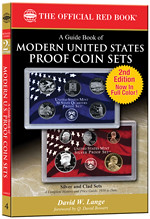 Whitman Publishing has released an expanded, updated second edition of David W. Lange's Guide Book of Modern United States Proof Coin Sets. The 256-page book, now in full color, is available online (including here, at WhitmanBooks.com) and from bookstores and hobby dealers nationwide. It retails for $19.95.
Whitman Publishing has released an expanded, updated second edition of David W. Lange's Guide Book of Modern United States Proof Coin Sets. The 256-page book, now in full color, is available online (including here, at WhitmanBooks.com) and from bookstores and hobby dealers nationwide. It retails for $19.95.
Proofs are the highest-quality specimens available of U.S. Mint coinage. Modern sets of these coins are very popular—collectors have bought more than 38 million in the past 10 years alone. Now award-winning numismatic researcher David W. Lange has updated, revised, and expanded his groundbreaking guide book. He offers a definitive history of the U.S. Mint's Proof coin sets, from the vintage period of 1936 to 1942, through the classic years of 1950 to 1964, the Special Mint Sets of 1965 to 1967, modern sets of 1968 to 1998, the 50 State Quarters® Proof sets of 1999 to 2008, and today's historically important sets with Presidential dollars and other current coins.
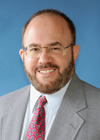 The new second edition includes:
The new second edition includes:
- 56 more pages than the first edition
- an illustrated history of Proof U.S. coins
- date-by-date analysis of each Proof set, starting with 1936, with full-color photographs
- original issue prices, values of uncertified sets, and values in several certified levels of Proof
- advice on collecting, storing, and displaying Proof coins
- a study of U.S. Mint packaging over the years
- certified coin population data
- official mintage and sales figures
- a photo gallery of earlier (18th- and 19th-century) Proofs
- close-ups of Proof coin die varieties, identified by Fivaz/Stanton number
In the foreword, Q. David Bowers writes, “Lange provides information not generally available even piecemeal in other texts, and nowhere available in a single place until now.”
This beautifully illustrated full-color book is bound in softcover, 256 pages, retail $19.95.
To read the complete article in the Whitman Review, see: (www.whitmanbooks.com/Default.aspx?Page=55&HTMLName=ReviewFBook1_0710)
BOOK REVIEW: ASTRONOMICAL SYMBOLS ON ANCIENT AND MEDIEVAL COINS
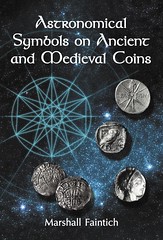 Astronomical Symbols on Ancient and Medieval Coins
by Marshall Faintich
Astronomical Symbols on Ancient and Medieval Coins
by Marshall Faintich
Review by Dr Kavan U. Ratnatunga (Astrophysicist and Numismatist)
http://coins.lakdiva.org
1-412-567-2917 (SkypeIn to Sri Lanka GMT+05:30)
Over a decade ago when I looked for information about Coins and Astronomy I found Marshall Faintich's website "Symbolic Messengers" hosted on OurWorld of CompuServe. It was one of only two websites dealing with the subject and I linked from the page I created for Lankan coins with Astronomy symbols. OurWorld in no more and the website has now moved to its own domain symbolicmessengers.com.
I am very happy to find that Marshall Faintich has expanded his website into a comprehensive book on Astronomy symbols on Coins Ancient and Medieval Europe.
To quote late Philip Grierson (1910-2006), who was Professor of Numismatics at University of Cambridge:
Numismatics, like some aspects of astronomy and natural history, remains a branch of learning in which the amateur can still do valuable work, and it is on the great collecting public, or rather on that part of which is interested in the subject at a scientific level, that the progress of numismatic science largely depends.
This book covers both these fields
The rate of rotation of the Earth is slowing very slightly and it is estimated that the length of the modern day appears to have increased by a surplus of about +0.05 seconds from the length of the ancient day 2500 years ago. The resulting cumulative correction of Universal Time known as Delta-T amounts to about 4.7 hours when you compute astronomical events back in 500 BCE. Before 1600 AD this can only be estimated empirically by records of Solar Eclipses, the most ancient of which are mainly from China. The consistency of the European numismatic record of Eclipses as shown in this book is an independent confirmation of the adopted Delta-T estimates.
As the Author admits it is unlikely that all the symbols identified as astronomical on over 400 coins illustrated in this book are factual, but it is clear that a large majority of them probably have been correctly identified.
All of the coins are illustrated with clear line drawing. It is a pity that images of few of the actual coins were not shown as images. Few of the coin images can however be seen on his symbolicm essengers website. I hope he expands that site with more images and references to the discussion in the book.
Faintich gives many examples of the Sun, Moon and 5 planets known to the ancients and their conjunctions, as well as comets and Galactic SuperNova visible in daylight that were recorded on Ancient and Medieval European coins.
Astronomical Symbols are also found on coins of south Asia including Lanka. I found it interesting that some of the same symbols such as the "three pellets" are found on Ancient Lankan coins which were first issued in 2 century BC. Each culture seems to have their own interpretation for this symbol which probably has a common ancient origin.
The crescent Sun during a partial eclipse is represented like a crescent Moon, however the orientation of the crescent should give some indication. The cusps of the crescent which point away from the Sun can't be seen pointing down at night.
Another recommendation for anyone trying to match coins with ancient Eclipses is to use the NASA Eclipse website which has a Five Millennium Catalog of Solar Eclipses at http://eclipse.gsfc.nasa.gov/SEcat5/SEcatalog.html This site is simpler to use than any program and adopts the current best algorithms and estimates for delta-T.
This book was published in 2008 should have gotten more publicity in 2009, the International Year of Astronomy when many nations issued coins to commemorate IYA2009 and there is a new set of coins with Astronomical Symbols.
Archaeoastronomy is becoming a growing field of interest. An IAU Symposium 278 (Oxford IX conference): "Archaeoastronomy and Ethnoastronomy: Building Bridges between Cultures", is being sponsored by IAU Division XII, on 2011 Jan 5-12 in Lima, Peru. See http://www.archaeoastronomy.org/ . I hope Marshall Faintich presents his findings at this conference.
Although the emphasis of the book on Medieval European coins, the book will serve as a very useful handbook for anyone attempting a similar study of other regions and cultures and other Eras. I recommend it for any Numismatic Library.
http://www.symbolicmessengers.com/primer.htm
http://www.symbolicmessengers.com/virtual.htm
http://web.archive.org/web/19981205005530/http://ourworld.compuserve.com
/homepages/symbolic_messengers/
http://coins.lakdiva.org/astronomy.html
To read the earlier E-Sylum review, see: BOOK REVIEW: ASTRONOMICAL SYMBOLS ON ANCIENT AND MEDIEVAL COINS (www.coinbooks.org/club_nbs_esylum_v13n26.html#article6)
BOOK REVIEW: GOLD: EVERYTHING YOU NEED TO KNOW TO BUY AND SELL TODAY
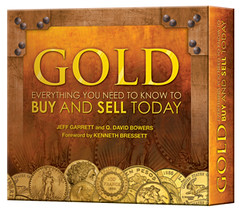 “Gold: Everything You Need to Know to Buy and Sell Today”
“Gold: Everything You Need to Know to Buy and Sell Today”
Authors: Jeff Garrett and Q. David Bowers, Foreword by Kenneth Bressett
Reviewed by: John and Nancy Wilson, NLG
Two of the country's most famous researchers and gold coin dealers, Jeff Garrett and Q. David Bowers, have produced an amazing book showing how to buy and sell gold most effectively and profitability.
This new book helps readers understand today's gold market. It starts with the basics of gold from, ancient times to modern and includes beautiful full color pictures of many rare and interesting gold coins. The book is hard cover and is in a hard pocket to protect it. The book covers the gambit from the recent gold boom to selling your gold and buying gold. It advises dealing with experts and discusses counterfeit and altered gold coins. Answers to frequently asked questions helps with many important areas of concern to readers.
The book also has ten pockets with pullout sheets which have interesting charts to use on the convention floor. The charts show weight conversion - for gold grams to pennyweight and the value with gold shown at prices from $900 to $1550 per ounce. Another shows bullion values of common U. S. and world gold coins at gold values from $800 to $1500 per ounce. Still another chart shows weights and tolerances as well as diameters of US gold coins for counterfeit detection. The last chart shows the names and addresses of many of the world mints. Because they are pullouts they can be taken wherever you are dealing without having to take the entire book.
“Gold: Everything You Need to Know to Buy and Sell Today,” released recently, (Copyright 2010), will be a new Whitman Publishing reference that will be carried to conventions like many of its other products. We think this new reference will be very useful not only for new comers and investors; but also for advanced numismatists. It is reasonably priced at $12.95 from Whitman who can be contacted at: Whitman Publishing, LLC, 3103 Clairmont Road, Suite B, Atlanta, Georgia, Call Center: (800) 546-2995 (8:00a.m. – 5:00p.m Central Time) or visit their web page at www.whitmanbooks.com .
To read the earlier E-Sylum review, see: BOOK REVIEW: GOLD: EVERYTHING YOU NEED TO KNOW TO BUY AND SELL TODAY (www.coinbooks.org/esylum_v13n28a06.html)
THE BOOK BAZARRE
QUERY: ALAIN DEBELDER'S BELGISCH NOODGELD SOUGHT
Howard A. Daniel III writes:
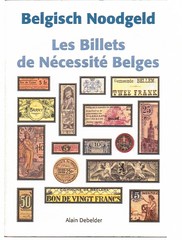 Over a couple of years, I have heard or had people write to me requesting I assist them in acquiring a numismatic reference that was published in last two or three years. The title is Belgisch Noodgeld (in Flemish) and Les Billets de Necessite Belges (in French) by a Belgian writer by the name of Alain Debelder.
Over a couple of years, I have heard or had people write to me requesting I assist them in acquiring a numismatic reference that was published in last two or three years. The title is Belgisch Noodgeld (in Flemish) and Les Billets de Necessite Belges (in French) by a Belgian writer by the name of Alain Debelder.
It was sent to and reviewed by the IBNS Book of the Year committee and one of them made an image of the cover for me. Since then, no one I know has seen any other copies.
I have not been able to find this reference available from any of the sources known to me, including many in Europe. I am afraid it was a VERY limited edition and is sold out but I will not give up hope until I learn more about it. If anyone has contact information for the author or knows where the reference can be purchased, please contact me at HADaniel3@msn.com.
QUERY: SAMUEL MOORE AND ADAM ECKFELDT INFORMATION SOUGHT
Mike Dlugosz writes:
I am doing some research on Samuel Moore which in turn has led me to seek out more information on Adam Eckfeldt. Since they worked together I am doubting that they ever communicated with each other via letter, but I would be interested in finding papers/correspondence of Moore and Eckfeldt, separately.
I have been to the National Archives in Pennsylvania but am not sure that what I am looking for is there. I plan to look at UPENN and the Bucks County Historical society for Moore's papers but don't know where to begin with Eckfeldt. Any help you could offer would be greatly appreciated.
MORE ON MEDAL ENGRAVER BLUMENFELD
1. Engraver Blumenfeld is not listed in Forrer. My conclusion: If Dick Johnson does not know the first name of engraver Blumenfeld, that information is not to be known.
2. What do P.O.C. and S.F.C. stand for? My first thought was "Port of Chicago" and "San Francisco, California."
3. Others speculate that S.F.C. stands for "San Francisco Chronicle," since M. H. De Young was the owner. This speculation extends to the thought that Blumenfeld worked for the Chronicle. I will continue to describe this as speculative until someone comes up with better documentation.
4. New puzzle question: What do the letters P.O.C. mean when applied to a Schenkman 48? (As in Schenkman 48 P.O.C.)
5. Answer to question above: Pile of Crap. (Sorry to drop the E-Sylum to that level, but you (or Kraljevich) started it.)
To read the earlier E-Sylum article, see: NUMISMATIC VOCABULARY: ITINERANT ENGRAVER (www.coinbooks.org/esylum_v13n28a13.html)
MORE ON THE NEW ENGLAND NUMISMATIC AND ARCHAEOLOGICAL SOCIETY PRLS
 In an earlier E-Sylum,
David Stone of Heritage Numismatic Auctions wrote:
In an earlier E-Sylum,
David Stone of Heritage Numismatic Auctions wrote:
Regarding Dave Hirt's query on the PRL's published by the New England Numismatic and Archaeological Society, there were at least eight numbers in the series.
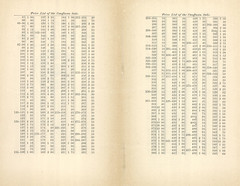

To read the earlier E-Sylum article, see: MORE ON THE NEW ENGLAND NUMISMATIC AND ARCHAEOLOGICAL SOCIETY PRLS (www.coinbooks.org/esylum_v13n21a16.html)
ON RESTORING LEATHER BOOK COVERS
 A bookbinder who specializes in RESTORATION (critical point) could recolor
the leather assuming the material has not dried out. Once the leather
dries out, rebinding is a much better long-term solution.
A bookbinder who specializes in RESTORATION (critical point) could recolor
the leather assuming the material has not dried out. Once the leather
dries out, rebinding is a much better long-term solution.
Regarding the risk of light exposure to one's collection, I have taken numerous precautions to ensure the important and rare 19th century literature in my collection is protected from any sunlight exposure including bookcase placement and archival acid-free storage boxes.
Most recently I went one step further and had a variety of windows in my house covered with ceramic film. The film eliminates 99% of the UV light (high risk), reduces heat in the house (go green), and is removable in the future.
Unlike older films which simultaneously made the house interior dark, the newer high-tech films only reduce light and color contrast by roughly 10% .....hardly noticeable after a couple of days. A 6-foot by 4-foot window cost roughly $300 to cover, which is much less than the cost to repair a single leather binding.
So ...... a bit of prevention can be a great investment.
Kim Ghobrial adds:
I've used RenWax on my leather covered books, as it can be used for this, besides coins or other artifacts.
To read the earlier E-Sylum article, see: QUERY: RESTORING LEATHER BOOK COVERS (www.coinbooks.org/esylum_v13n28a12.html)
QUERY: VIETNAMESE BANKNOTE OVERSTAMP TRANSLATION SOUGHT
I have been working for several months trying to find and bring together all of my numismatic pieces of a pre-united Viet Nam in every crook, cranny, corner, box, drawer, shelf, envelope, etc. During this work, I recently came across something that I know does not belong to me. I seem to remember it coming from Europe but right now I cannot find the envelope. With my heavy correspondence and stacks of mail always all over my office, I ask the collector or dealer to send me a color photocopy or scan instead of the actual piece, so I do not misplace it like I did with this note. But this owner mailed the actual piece to me.
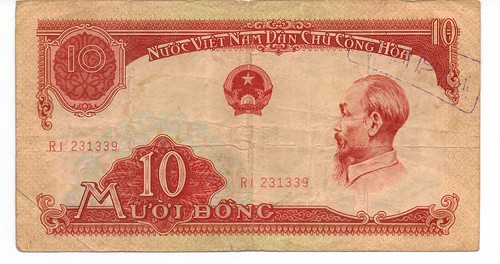
It is a Series 1958 Democratic Republic of Viet Nam 10 Dong bank note. It is usually cataloged under North Viet Nam and in Pick it is numbered 74a for the issued note. For the same note with a Da Thu overstamp, it is numbered 74b. The Da Thu overstamp was applied on May 3, 1978 when this note was exchanged for Series 1976 coins and notes.
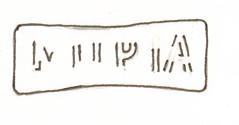 The note I just re-found has an overstamp on it too but the word is Mupia or Nupia or something else. The word could mean exchanged, cancelled or annulled. The note could have been exchanged in a Vietnamese Embassy somewhere in Europe and they applied an overstamp on it in the local language. Or someone tried to exchange it for a local currency after it became demonetized and the bank or foreign exchange in that country overstamped it.
The note I just re-found has an overstamp on it too but the word is Mupia or Nupia or something else. The word could mean exchanged, cancelled or annulled. The note could have been exchanged in a Vietnamese Embassy somewhere in Europe and they applied an overstamp on it in the local language. Or someone tried to exchange it for a local currency after it became demonetized and the bank or foreign exchange in that country overstamped it.
Besides showing the actual note with the overstamp in its upper right corner, I am also showing what I believe to be what I can see of the overstamp. My question is; can someone fluent in the language of the overstamp translate it for me? Thank you in advance for anyone translates it. And if the owner knows this note is his, please contact me at HADaniel3@msn.com, so I can return it. I am pretty sure I know who owns it but my recent letter to him came back with address unknown overstamped on it.
QUERY: ROBERT READY AND SONS, ELECTROTYPISTS
Charley Marsteller writes:
"I am seeking bibliographical information on Robert Ready and his sons, electrotypists for the British Museum in the late 19th-early 20th Centuries, the era when the British Museum used electrotypes in their public displays, keeping the coins themselves locked in the vaults. In 1884, a large sample of the electrotypes of Ready and sons entered the collection of the American Numismatic Society where they still reside today."
THE BOOK BAZARRE
ARTICLE PROFILES BILL BURD AND HIS NUMISMATIC LIBRARY
 You can't tell a book by it's cover, they say, and you can't know what's behind a door until you open it.
You can't tell a book by it's cover, they say, and you can't know what's behind a door until you open it.
Both axioms hold true for visitors to the Chicago Coin Company, Inc.
Located behind a nondescript storefront on on Archer Avenue on Chicago's southwest side, just a mile or so west of Midway Airport, is an inner sanctum that is truly something to behold.
Back behind the shop area, owner William Burd's modest office, and the work and shipping areas that support the business operation, is a spacious, well appointed, extensive and comprehensive numismatic reference library. Upon its shelves rest more than 12,000 reference books, catalogs, periodicals and pamphlets covering a diversity of interests from ancient to modern.
To say that this repository of numismatic knowledge makes the Chicago Coin Company one of the most unusual coin shops in the country would certainly be an understatement. The story behind the library, the location and the principal is an interesting one.
In 1994, prior to striking out on his own, Burd had started researching numismatic subjects for his personal curiosity. Among the early topics researched were the history of the 1894-S dime and the second San Francisco Mint and the career of Superintendent Oscar LaGrange. Those forays led him into writing a couple articles that found publication in The Numismatist and led him to start building a reference library for personal use.
When he took over the Daru Coin shop, renaming it the Chicago Coin Company a couple years later, Burd said that all of the reference books he had at hand would probably have fit into two modest-sized cartons. At that time he was finding it necessary to frequently rely upon the resources of the American Numismatic Association library to fill in the research gaps.
Through the first 10 years of operating the Chicago Coin Company, Burd gradually expanded those modest research holdings into a budding library to meet his business needs and personal desires. He realized it was probable that others might find it useful to consult the reference works he had assembled, by which time numbered somewhat more than 5,000.
The number of items in the library has more than doubled over the past five years, Burd said, with a focus on filling in gaps with missing titles, catalogs and related studies. Within the past two years he has started promoting the availability of the library for public use with advanced inquiry. The references may be consulted only on site, but photocopies in satisfaction of specific needs will be honored.
The Chicago Coin Company reference library was relocated into renovated and expanded quarters earlier this year, with an open house hosted on April 17 with about 60 interested collectors and scholars from the area in attendance.
The library guest register they and other visitors sign into is maintained in a century old journal of Virgil Brand's buyer, Theophile E. Leon, who conducted business in the early decades of the 20th century. As a predecessor to the Chicago Coin Company, it contains some of his important contact and transaction records in his own hand.
If you're a serious collector or numismatic scholar who would appreciate a visit to a fine and appealing library, you owe it to yourself to make it a point to arrange to pay a visit to the Chicago Coin Company reference library.
Any inquiries concerning utilization of the library should be directed to Bill Burd at the Chicago Coin Company, 6455 West Archer Avenue, Chicago, IL 60638. The phone number is; 773-586-7666. The website is www.chicagocoin.com .
To read the complete article, see: Chicago coin shop houses library (www.numismaticnews.net//article/?p_ArticleId=11970)
MORE ON THE LIBRARY OF COINS AND TREASURY OF COINS ALBUMS
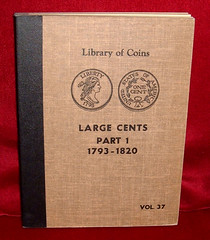 I can't wait to acquire and read a copy of David Lange's book on the Library of Coins albums. I remember as a teenager visiting the up-a-flight-of-22-noisy-wooden-stairs coin shop of one Mr. Rippberger in Rockford IL and seeing the entire collection of LOC albums on display on a high shelf. Indeed, I kept my own collection of Lincoln cents in them! Those albums are handsome, but somewhat fragile; if not handled and stored carefully, their taped bindings will quickly rack, especially now after half a century of glue deterioration.
I can't wait to acquire and read a copy of David Lange's book on the Library of Coins albums. I remember as a teenager visiting the up-a-flight-of-22-noisy-wooden-stairs coin shop of one Mr. Rippberger in Rockford IL and seeing the entire collection of LOC albums on display on a high shelf. Indeed, I kept my own collection of Lincoln cents in them! Those albums are handsome, but somewhat fragile; if not handled and stored carefully, their taped bindings will quickly rack, especially now after half a century of glue deterioration.
An interesting feature of those albums was that they normally included "everything" that had a Redbook listing, or at least close to everything. Thus did the Indian cent album call for an 1856 flyer, while the Lincoln cent albums called for both a 1922-P and a 1955 doubled die. If one had started collecting those series in the blue Whitman folders (who didn't?) and then "graduated" to the LOC, his want list would immediately grow by three very expensive coins!
Toward the end of the LOC era (late 1960s) a new series of albums was released, apparently in very low press runs considering their scarcity today, to include albums for most all series of U.S. coins. The pair of albums for large cents is of particular interest to me, in that it calls for most (but for some reason not all) of the Redbook varieties, 128 coins in all.
There are some toughies in there, such as the 1793 liberty cap and the 1803 large date, small fraction, but it is still possible to finish this "complete" set even today. The half cent album, on the other hand, supplies two openings each for both 1796- and 1802-dated coins. Perhaps the Coin & Currency Institute editors were dreamers, perhaps they were sadists, but it was close to impossible then, and it is close to impossible now to fill the holes for 1796 no pole and 1802, reverse of 1800.
Users of this album series to collect and house the early silver issues will find multiple varieties required of those difficult and expensive dates in the 1790s. I wonder how many such people there really are, or if they just collect the albums out of nostalgia.
To read the earlier E-Sylum article, see: THE LIBRARY OF COINS AND TREASURY OF COINS ALBUMS (www.coinbooks.org/esylum_v13n28a10.html)
CHIPS, THE DOG WITH A PURPLE HEART
David Klinger writes:
During WWII a dog named Chips was awarded a Silver Star and a Purple Heart.
 Spirited and quick to learn, Chips served bravely as a tank guard dog, traveling throughout Europe, Africa, and Italy with General Patton's Seventh Army.
Spirited and quick to learn, Chips served bravely as a tank guard dog, traveling throughout Europe, Africa, and Italy with General Patton's Seventh Army.
On one occasion, Chips alerted to an impending ambush. Then, with a phone cable attached to his collar, Chips ran back to base, dodging gunfire so that the endangered platoon could establish a communications line and ask for the backup they so desperately needed.
Perhaps the event that most exemplifies his courage and devotion occurred early one morning on a beach in Sicily. As he and his handler proceeded up the beach, they came under fire from a disguised pillbox. Chips broke free from his handler and launched himself right into the pillbox. Moments later several bitten and surrendering Italian soldiers emerged, all shepherded by a very determined Chips.
Though wounded in the melee, Chips returned to duty that night, and alerted troops to an approaching group of Italians. This allowed his handler and squad time to capture all of them.
Chips was a true hero. He was awarded a Silver Star for valor, and a Purple Heart for his wounds. The newspapers heralded his exploits. Unfortunately, the press attracted the attention of the Commander of the Order of the Purple Heart. He complained to both President Roosevelt and the War Department, claiming that by so honoring Chips, they were demeaning all the men who have been awarded a Purple Heart. Chips' medals were taken away, and he was given an honorable discharge and returned to his family in Pleasantville. No military dog has received an official decoration since.
To read the complete article, see: Chips: Decorated War Hero (www.military.com/NewContent/0,13190,K9_051605,00.html)
To read the earlier E-Sylum article, see: THE PDSA GOLD MEDAL: "THE GEORGE CROSS FOR ANIMALS" (www.coinbooks.org/esylum_v13n28a26.html)
OPINION: TIM SHUCK ON COIN DESIGN BY COMMITTEE
Tim L. Shuck of Ames, IA writes:
The CCAC is on a mission to improve the designs of U.S. coins. As the first bold step to accomplish this goal, they established a subcommittee. Seriously.
Along with the new Subcommittee on Coin Design Excellence, the effort also produced a ‘visual definition of design excellence', which includes an image reference guide of 25 U.S. coin designs and 39 world coin and medal designs, and a helpful list of 17 characteristics of design excellence. The latter bears repeating in entirety (as quoted in Coin World):
- use of texture and pattern
- meaningful negative space
- thoughtful relationship of negative to positive space
- stylization
- ethnical influences
- allegory and symbolism
- detail yes, crowding no
- use of perspective
- used of forced perspective
- minimal layers
- harmonious, restrained type styles
- clarity
- interwoven images, not busy collages
- contrast of texture and smooth
- fluidity
- subtlety
- relevance of obverse to reverse
Ok, pop quiz. In 25 words or less, describe precisely what any three of these list items mean, as applied to coin design, and discuss whether that item is or is not currently identifiable on any U.S. coin. Points will be deducted for the use of jargon. Bonus: show which items in the list are more or less the same as other items in the list.
The 17 characteristics are intended to be “a benchmark to inspire those who design U.S. coins to be more innovative and creative.” Though “not trying to blame anyone or point fingers”, and noting that “we believe we have some wonderful artists and don't doubt their talent at all”, it is the work of these same artists with which the CCAC seems to find fault. Were I a current Mint coin designer I would be skeptical of the CCAC's non-finger-pointing assurance.
This endeavor seems to be an attempt to quantify the answer to the basic question of “What is good design?”. The implication is that good design will happen if all 17 guidelines are met. Oh, and by being inspired by the 39-item reference guide set. Certainly there are principles to which good design adheres, but can excellent creative results be summoned by following a list? It seems obvious to note that design appreciation is subject to the experience and interests of the viewer. Great art for thee is not necessarily great art for me.
The Subcommittee on Coin Design Excellence is a classic bureaucratic response to a perceived problem: create committees, study the issue for awhile, create guidelines, apply guidelines, have a bunch of meetings, and then congratulate yourself for solving the problem. Or, possibly, bemoan the fact that people aren't listening to you. The reality of such efforts is that the process often becomes more important than results.
Tim adds:
To read the complete article, see:
Great Coin Design, by Committee
(www.coinlink.com/News/commentary-and-opinion/
great-coin-design-by-committee/)
NOTES FROM E-SYLUM READERS: JULY 18, 2010
Redbook Prices
Regarding the discussion on how Whitman Publishing derives prices for A Guide Book of United States Coins, James Higby writes:
It has always been a source of irritation to hear people disparage and dismiss the Redbook price listings as "being obsolete the moment they hit the streets." This is no more true of the Redbook than of any other pricing source, particularly with techniques available today. I could cite online price guides that are touted as being up-to-the-minute, but which contain lines that have not been revised for months or even years, in spite of massive market trends upward. That said, I would mortgage everything I own to be able to purchase problem-free examples of certain items at Redbook prices. Dimes dated 1804 and 1874-CC in circulated grades come to mind.
Thoughts from Joe Boling
Joe Boling writes:
Having been tied up in Colorado Springs for fifteen days at the summer seminar, I am two weeks behind in processing email. Thus I am only tonight opening the 4 July E-Sylum.
Regarding Dan Hamelberg's announcement that NBS will again be sponsoring a $1000 summer seminar scholarship for a YN, let me suggest that with all the money that pours into YN pools annually (not to mention last year's $250k donation by Dwight Manley for YN scholarships), maybe the NBS should sponsor a scholarship that an Old Numismatist could also compete for. Make it an open field.
As for voting for the top Asylum articles, I took the ballot to CS with me, but never got a free hour to go to the library and read the 2009 issues. By the time I got home and dug out, the deadline was too close to make it.
Paper Money of Ireland won the IBNS book of the year award for 2009, announced in Memphis last month.
The ANA's "no early-birds" policy for exhibitors applies only to opening day. On subsequent days, exhibitors get to come in with the dealers. The objective, as stated several times, is to allow dealers to set up in peace and quiet.
Now to the 11 July issue.
"A numismatist (at least an American one) will remind the grammarian that there are ten grades of Uncirculated." And a mathematician will remind the numismatist that there are eleven grades of uncirculated.
ANA Numismatic Theatre
Brad Karoleff writes:
Thanks for the plug for the Numismatic Theater early U. S. minting technology panel discussion on Friday, August 13th. You published an incomplete list of the participants for the discussion. The panel will consist of the following noted numismatists:
- John Dannreuther, noted author and former numismatist of the year award winner
- Dr. Richard Doty curator of the National Numismatic Collection and famous author
- Bill Eckberg noted half cent collector and researcher
- R. W. (Bob) Julian prolific writer and researcher, winner of the Clemy
- Doug Mudd author and curator of the ANA Money Museum collection
- Craig Sholley author and researcher famous for his extensive research into the Mint archives in Philadelphia
I will "host" the panel discussion which will consist of introduction questions to the panelists and their responses. The panel and members of the audience will be encouraged to ask questions of the panel. Come prepared to participate and expand your knowledge of the screw press and its use.
We all look forward to seeing you there!
Seldom-Seen Denominations
Granvyl Hulse writes:
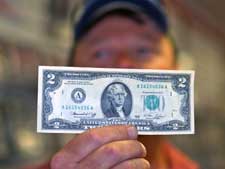 Rick Nadig's store is right down the street from me in the old Walker House. One of the oldest houses in town which he completely re-modeled several years ago. That house had the first indoor bathroom which he carefully removed when he remodeled and we have it in our town museum. The Union Leader article is quite true. If you see anyone with either a two dollar bill or a fifty cent piece you know they have been in to his store to get a movie or an ice cream cone.
Rick Nadig's store is right down the street from me in the old Walker House. One of the oldest houses in town which he completely re-modeled several years ago. That house had the first indoor bathroom which he carefully removed when he remodeled and we have it in our town museum. The Union Leader article is quite true. If you see anyone with either a two dollar bill or a fifty cent piece you know they have been in to his store to get a movie or an ice cream cone.
On a related note, Colin Gullberg writes:
I was amused at the story where Taco Bell is urging increased use of two-dollar bills. Here's another article on using $2 bills. It's a little old [2005] but a classic.
PUT YOURSELF in Mike Bolesta's place. On the morning of Feb. 20, he buys a new radio-CD player for his 17-year-old son Christopher's car. He pays the $114 installation charge with 57 crisp new $2 bills, which, when last observed, were still considered legitimate currency in the United States proper. The $2 bills are Bolesta's idea of payment, and his little comic protest, too.
For this, Bolesta, Baltimore County resident, innocent citizen, owner of Capital City Student Tours, finds himself under arrest.
Finds himself, in front of a store full of customers at the Best Buy on York Road in Lutherville, locked into handcuffs and leg irons.
Bolesta was then taken to the county police lockup in Cockeysville, where he sat handcuffed to a pole and in leg irons while the Secret Service was called in.
"At this point," he says, "I'm a mass murderer."
Finally, Secret Service agent Leigh Turner arrived, examined the bills and said they were legitimate.
To read the complete article, see:
A tale of customer service, justice and currency as funny as a $2 bill
(articles.baltimoresun.com/2005-03-08/news/0503080089
_1_bolesta-pole-baltimore-county)
To read the earlier E-Sylum article, see: NEW HAMPSHIRE MERCHANT GETS ATTENTION WITH SELDOM SEEN DENOMINATIONS (www.coinbooks.org/esylum_v13n28a23.html)
Charities Mail Coins With Donation Pleas
Joel Orosz writes:
Here is an interesting article on the intersection of philanthropy and coinage.
A growing number of charities across the USA are taking a nickel-and-dime approach to encourage donations by mail, despite some evidence that including coins in solicitations turns off potential donors.
Paul Bobnak, director for "Who's Mailing What!" a service that collects data on direct mail operations, says the company's records show the use of coins in charity mailings is increasing this year after several years of decline.
The Leukemia & Lymphoma Society did a mailing in April 2010, some with coins and some without, says Bruny Lynch, the national director of direct response fundraising. The envelopes with nickels earned 75% more than the others, Lynch said.
"Generally speaking, our coin package outperforms things we test against it two to one, " says Nick Ellinger, vice president of strategic outreach for Mothers Against Drunk Driving.
Kristi Kirschner, a mother of four from Springfield, Va., remembers being surprised to see a nickel attached to a UNICEF letter. It said 5 cents could save a child's life and asked her to return the coin with a donation.
"I think it's sort of a guilt tactic," Kirschner said. "I don't know how many nickels they send out, but that's got to add up to a lot of money." She said, "It wasn't my nickel, so I sent it back" — without a donation.
To read the complete article, see: Charities mail out coins, hope for larger return (www.usatoday.com/news/sharing/2010-07-14-charity-coins_N.htm)
ROY ROGERS' SILVER-DOLLAR STUDDED CAR
Inspired by our discussion of Buffalo Bill show show-thru coins, Larry Saryan writes:
Here is more on cowboys (and cowgirls) and coins: Roy Roger's car studded with silver dollars.
After sitting stuffed and mounted for more than 40 years in a museum, Roy Rogers' horse Trigger and dog Bullet will be TV stars once more. Rural cable network RFD-TV bought Bullet for $35,000 on Thursday and Trigger for $266,000 a day earlier at an auction in New York City.
RFD-TV owner Patrick Gottsch said the Omaha, Neb.-based network will begin airing old Roy Rogers movies on Saturdays starting November 6. The movie cowboy's son, Roy Jr., will introduce each film, as Trigger and Bullet stand in the background.
"The goal is to introduce Roy Rogers to a whole new generation of kids," Gottsch said.
Trigger and Bullet were part of a Christie's auction of items from the now-closed Roy Rogers and Dale Evans Museum in Branson, Mo.
On Thursday, more than 1,000 items hit the auction block, including the Rogers family dining set, which sold at $11,875, triple the presale estimate; Trigger's flower-bedecked straw hat, which fetched $2,750, compared with the $500 to $1,000 estimate; and the hand-drawn music and lyrics to "Happy Trails," which sold for $27,500, compared with the estimate of $500.
Elkies, the auctioneer, said it was the "most colorful, emotional and sentimental" sale she had experienced in her 20 years at Christie's. At the end of the auction, the audience broke out spontaneously in a rendition of the Roy Rogers theme song "Happy Trails."
To read the complete article, see: Roy Rogers' dog Bullet fetches $35K at NYC auction (www.aolnews.com/story/roy-rogers-auction-in-nyc-offers/1156611)
According to the Christie's catalogue:
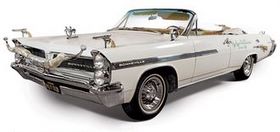 Beginning with a stock 1964 Pontiac Bonneville Convertible, Nudie removed all traces of the original interior material and carpeting, replacing it with exquisitely hand-tooled leather. Then came the application of hundreds of genuine collectible silver dollars, along with chrome-plated pistols, horseshoes, miniature horses and rifles...
Beginning with a stock 1964 Pontiac Bonneville Convertible, Nudie removed all traces of the original interior material and carpeting, replacing it with exquisitely hand-tooled leather. Then came the application of hundreds of genuine collectible silver dollars, along with chrome-plated pistols, horseshoes, miniature horses and rifles...
Nudie worked out the mechanics of six-shooters to the point where the pull of a trigger on the gear shift works the gears, other pistols open the doors and two more pistols on chrome stands replace the front seat arm rest. Still another pistol sounds the horn and two more open the doors from the outside.
Two derringers are also employed replacing the emergency brake release and the other works the directional lights. In all, Nudie has used 14 guns in Roy's western car...Natural-stocked rifles are mounted on the rear of the car, one on each fender and one mounted on the trunk lid... the trunk of the car is emblazoned with the name ROY ROGERS.
For an extra front-seat rider, Nudie has placed a fabulous silver saddle between the bucket seats, decorated with rhinestones and 150 silver dollars.
To read the complete article, see: WHAT WOULD ROY ROGERS RIDE? (moreintelligentlife.com/blog/what-would-roy-rogers-ride)
To read the earlier E-Sylum article, see: MORE BUFFALO BILL WILD WEST SHOW TARGET COINS (www.coinbooks.org/esylum_v13n28a11.html)
THE HOBBIES MAGAZINE BUILDING IN CHICAGO
Len Augsburger writes:
Some urban history here - we have a view looking north at 1006 S. Michigan in Chicago, and a 2nd view looking south.
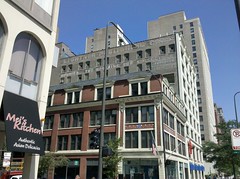
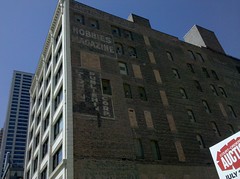
Both of the building sides exhibit old (1950s era?) ads for Hobbies Magazine, which, in the 40s and 50s featured a several page coin section every month. Frank C. Ross was the main contributor, though Thomas Elder and others also held forth. The publisher, Lightner, is still listed at this address.

I may have some copies of this publication in my library, but I can't put my hands on them. Does anyone have one or more issues? Could you share images of the covers with us? Thanks, Len - this is an interesting remnant of numismatic literature history. -Editor
THE BOOK BAZARRE
ARTICLE: TRINIDAD MAN READY TO PART WITH HIS "RARE" COIN
 IN his desperation to obtain money for surgery, 45-year-old Dexter Cyrus is now willing to sell a rare coin which has been in his family's possession for generations.
IN his desperation to obtain money for surgery, 45-year-old Dexter Cyrus is now willing to sell a rare coin which has been in his family's possession for generations.
It's a bronze half penny that Cyrus said was handed down over generations. He said one of his forefathers, who was a sugar plantation slave, was given the coin by his master.
The bronze half penny was first produced in 1860 when England was under the rule of Queen Victoria.
The "bun penny" got its name from the picture of Queen Victoria wearing her hair in a bun, engraved on the front by Leonard Charles Wyon, whose initials appear in the design. On the reverse side, a seated figure representing the then monarch was used. The half penny was no longer legal after 1969.
Cyrus claimed that the coin was first given to one of his forefathers who came to Trinidad as an immigrant to work on the plantation in Palmiste, South Trinidad. Cyrus said his forefather was an honest worker and as a reward for his hard work and dedication, he was given the coin by his English master. Since then, the coin has not left the family's possession.
Cyrus, a labourer and the father of two, said that in 1999 he suffered a back injury in an accident, affecting his ability to work. He is currently receiving assistance from the Government but says that it is not enough.
To read the complete article, see: Rare coin up for sale (www.trinidadexpress.com/news/98579479.html)
ARTICLE PROFILES FORMER B.E.P. ENGRAVER THOMAS HIPSCHEN
 Hipschen has engraved the portraits of Benjamin Franklin, Ulysses S. Grant, Andrew Jackson and Abraham Lincoln on U.S. currency.
Hipschen has engraved the portraits of Benjamin Franklin, Ulysses S. Grant, Andrew Jackson and Abraham Lincoln on U.S. currency.
For 38 years, Hipschen, a Bellevue, Iowa, native, worked as a banknote picture engraver for the United States Bureau of Engraving and Printing. The United States Stamp Society acknowledges him as being recognized worldwide as the finest U.S. picture engraver.
"People are amazed that someone still living can do something so archaic," Hipschen said jokingly. "It's very laborious, and now there are so many easier ways to make images that most people would never spend the time to do it."
Picture engravers use etching and engraving techniques to make portraits, landscapes and other designs in steel and copper dies, with a manner and style designed to prevent counterfeiting.
At 17, and after taking only one art class in high school, Hipschen stumbled upon a job working for the bureau in Virginia as part of a 10-year apprenticeship.
I had interviewed once already for the job, and they called me back for a second interview," he said. "I didn't want to go, but my dad talked me into it. I didn't realize that when I got there, they had already hired me."
With only a suitcase full of clothes, Hipschen accepted the position.
He has engraved more than 130 bureau-produced postage stamps for the U.S. Postal Service, and engraved the official portraits of Presidents Jimmy Carter, Ronald Reagan, George H.W. Bush, Bill Clinton and George W. Bush.
To read the complete article, see: His art is right on the money (www.thonline.com/article.cfm?id=289488)
ON GERMAN MICRO-CURRENCIES
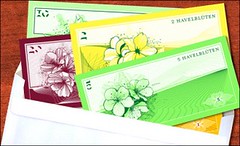 The Havelbluete, the Augusta and the Chiemgauer might sound like the names of locally brewed beers, but they are in fact micro-currencies which, like micro-breweries, are in abundance in Germany. There are more than two dozen local currencies in circulation, and 40 or so initiatives are about to start printing their own banknotes. These notes are not gimmicks. They're recognized legal tender -- at least within each local region.
The Havelbluete, the Augusta and the Chiemgauer might sound like the names of locally brewed beers, but they are in fact micro-currencies which, like micro-breweries, are in abundance in Germany. There are more than two dozen local currencies in circulation, and 40 or so initiatives are about to start printing their own banknotes. These notes are not gimmicks. They're recognized legal tender -- at least within each local region.
WESTERVELT: Artisanal pork and organic fruit and vegetables aren't the only locally made products exchanging hands. The regional currency, the Kingower is as well. Walburger Zanbugler(ph) is a local beef and pork farmer. At the front of her refrigerated stall, prominently displayed near the regional delicacy, Weisswurst, a sign in German reads, Kingower accepted here.
Ms. WALBURGER ZANBUGLER: (Through translator) I think it's a great initiative because it means that the money stays within the region. It's a kind of a give and take principle. So when I take the Kingower here, I also spend the currency here. That's the main reason why I take part.
WESTERVELT: The currency, based on the Euro, one Kingower equals one Euro, is printed locally. It aims to promote regional investment while also helping the community. It's not backed by any government body. But what used to be illegal gray area is now legal tender here. The Kingower, named after a region in Bavaria, is a depreciative currency. It loses two percent of its value at the end of each quarter. So that encourages people to spend, something the frugal Germans are notoriously unwilling to do.
If you don't use it fast, the currency has to be topped up by purchasing a dated stamp. Sixty percent of the fee you pay to bring the currency back up to full value goes to local nonprofit groups. The currency is now accepted in more than 600 regional businesses from banks to bread shops. And Andrea Sturzel's(ph) information technology company in Rosenheim.
Mr. ANDREA STURZEL: You are forced to spend money, its quite good thing. It's very easy to say I change 100 Euros in Kingower and I can spend it within two or three weeks. I can pay a doctor in Kingower. I can pay an architect in Kingower. Most pharmacies in the region you can pay in Kingower.
WESTERVELT: Local currencies such as the Kingower, the Havelbluete and the Nogle(ph) have been around for nearly eight years, almost as long as the Euro. In all there are now some 60 local currencies up and running or planned for Germany. Now, if there's a Euro-skeptic, Germany-first tinge to these local currencies, or even some nostalgia for the good old days of the Deutschmark, most people here deny it.
Local currency organizers see themselves as progressives who are softening the hard edges of a global economy. One of the program's partially subsidized by the Kingower's profits is an after school club.
To read the complete article, see: Fiscal Localism On Rise In Germany (www.npr.org/templates/story/story.php?storyId=128546325&sc=emaf)
 On a recent day, Christian Gelleri buys a sandwich and a glass of Hefeweizen at a rustic, sun-filled outdoor beer garden along the Inn River in the Upper Bavarian town of Stefanskirchen.
On a recent day, Christian Gelleri buys a sandwich and a glass of Hefeweizen at a rustic, sun-filled outdoor beer garden along the Inn River in the Upper Bavarian town of Stefanskirchen.
But the 40-year-old isn't paying with euros. The bar also accepts chiemgauer, the thriving local currency named after a region in Bavaria.
The alternative currency is not some gimmicky fundraiser. It may look a little like Monopoly money, but the chiemgauer is real. One chiemgauer equals one euro. It's been around for eight years, almost as long as the euro, the common currency now used by 16 of the 27 EU members.
Gelleri, a high school teacher who established the chiemgauer, is proud that more than 600 regional businesses — from drugstores to architects — now accept the microcurrency.
To read the complete article, see: From Stalwart To Skeptic, Germany Rethinks EU Role (www.npr.org/templates/story/story.php?storyId=128462416)
INDIA UNVEILS NEW RUPEE SYMBOL
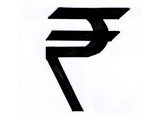 It may look like a melted British Rail sign but it's hoped that a new symbol for the Indian rupee will signal India's growing economic strength ‑ and it will be coming soon to a keyboard near you.
It may look like a melted British Rail sign but it's hoped that a new symbol for the Indian rupee will signal India's growing economic strength ‑ and it will be coming soon to a keyboard near you.
The winning design was selected by the Indian cabinet yesterday from a shortlist of five following a national competition.
Measures are already afoot to have the rupee sign declared a computer standard, meaning it could join currencies such as the pound, dollar, euro and yen on keyboards within two years.
"The distinct symbol denotes the robustness of the Indian economy," India's information minister, Ambika Soni, said.
References to sums in rupees currently involve spelling out the word (as is the case in the Guardian's style guide) or giving it the abbreviation Rs or INRs to distinguish it from other Asian countries that use rupees or variations thereof.
"Once accepted, it will stand clear from the clutter of currencies that call themselves rupee or the rupiah," India's Telegraph reported.
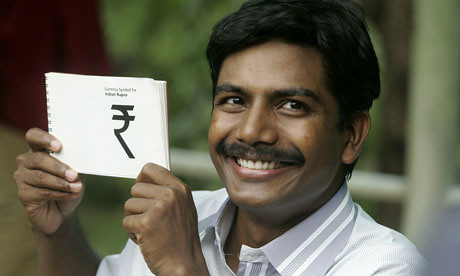
The winning symbol was the work of Udaya Kumar, a lecture in design at the Indian Institute of Technology in Mumbai. Speaking to the Indian news website Rediff.com he said: "My design is based on the tricolour, with two lines at the top and white space in between. I wanted the symbol for the rupee to represent the Indian flag. It is a perfect blend of Indian and Roman letters: a capital 'R' and Devanagari 'ra' which represents rupiya, to appeal to international audiences and Indian audiences."
To read the complete article, see: India unveils new rupee symbol (www.guardian.co.uk/world/2010/jul/16/india-rupee-symbol)
CONFUSION REIGNS AS SOUTH AFRICA OUTLAWS OLD BANKNOTES
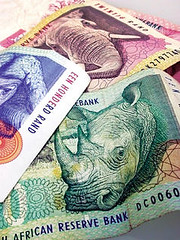 To combat fake money, South Africa made all bills older than 2005 illegal. Problem is, South African money does not show the year of issue.
To combat fake money, South Africa made all bills older than 2005 illegal. Problem is, South African money does not show the year of issue.
Since 2005, a number of new security measures, such as raised lettering and an iridescent band, have been used for paper currency, including the 200 rand note. Older bills, naturally, were easier to fake.
When the South Africa Reserve Bank announced a deadline for exchanging old bills at the end of May, it was supposed to alleviate concerns about fraudulent currency. Instead, it created confusion and panic about what was still legal tender.
“Old” refers to bills that predate 2005, but herein lies the problem: South African money does not show the year of issue. Some shops would no longer accept bills from the old series; others wouldn't take 200 rand notes at all.
To read the complete article, see:
Getting stuck with fake money in South Africa
(www.csmonitor.com/World/Global-News/2010/0715
/Getting-stuck-with-fake-money-in-South-Africa)
FEATURED WEB SITE: EUROCOLLEZIONE, A EURO COINS SITE
This week's Featured Web Site is suggested by David Gladfelter, who writes:
Have you seen this web site? It looks more informational than commercial.

eurocollezione.altervista.org

